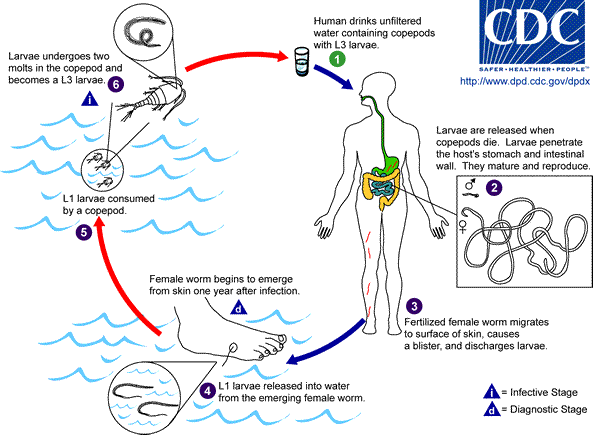| |
Humans become infected
by drinking unfiltered water containing copepods (small crustaceans) which
are infected with larvae of D. medinensis
 .
Following ingestion, the copepods die and release the larvae, which
penetrate the host stomach and intestinal wall and enter the abdominal
cavity and retroperitoneal space .
Following ingestion, the copepods die and release the larvae, which
penetrate the host stomach and intestinal wall and enter the abdominal
cavity and retroperitoneal space
 . After
maturation into adults and copulation, the male worms die and the females
(length: 70 to 120 cm) migrate in the subcutaneous tissues towards the skin
surface . After
maturation into adults and copulation, the male worms die and the females
(length: 70 to 120 cm) migrate in the subcutaneous tissues towards the skin
surface  .
Approximately one year after infection, the female worm induces a blister on
the skin, generally on the distal lower extremity, which ruptures. When
this lesion comes into contact with water, a contact that the patient seeks
to relieve the local discomfort, the female worm emerges and releases larvae .
Approximately one year after infection, the female worm induces a blister on
the skin, generally on the distal lower extremity, which ruptures. When
this lesion comes into contact with water, a contact that the patient seeks
to relieve the local discomfort, the female worm emerges and releases larvae
 . The
larvae are ingested by a copepod . The
larvae are ingested by a copepod
 and
after two weeks (and two molts) have developed into infective larvae and
after two weeks (and two molts) have developed into infective larvae
 .
Ingestion of the copepods closes the cycle .
Ingestion of the copepods closes the cycle
 . . |
|
